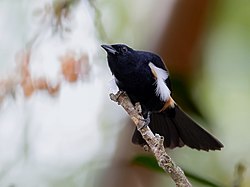| Fulvous-crested tanager | |
|---|---|
 | |
| Male | |
 | |
| Female | |
| Scientific classification | |
| Kingdom: | Animalia |
| Phylum: | Chordata |
| Class: | Aves |
| Order: | Passeriformes |
| Family: | Thraupidae |
| Genus: | Tachyphonus |
| Species: | T. surinamus |
| Binomial name | |
| Tachyphonus surinamus (Linnaeus, 1766) | |
 | |
| Synonyms | |
| |
The fulvous-crested tanager (Tachyphonus surinamus) is a species of bird in the family Thraupidae, the tanagers.
Contents
It is found in Brazil, Colombia, Ecuador, French Guiana, Guyana, Peru, Suriname, and Venezuela. Its natural habitat is subtropical or tropical moist lowland forests.
The fulvous-crested tanager is found in the entire Amazon Basin, but only the downstream third of the southern half, in the southeast and southwest. The species ranges into the Guianas in the northeast, and the Orinoco River drainage of Venezuela in the northwest; for its range limit, it is not found in the western or northern regions of the Orinoco drainage.
